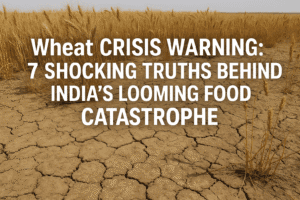Wheat Crisis Warning: 7 Shocking Truths Behind India’s Looming Food Catastrophe
A stark study in Nature reveals that even with significant adaptation efforts by farmers, climate change threatens catastrophic agricultural losses, with India’s vital northern wheat regions facing particularly devastating declines of 40-100% by 2100 under high emissions. While adaptation measures like altered planting and new varieties are crucial, they can only offset about one-third of projected global yield losses, proving least effective for highly temperature-sensitive wheat compared to crops like rice. This failure hits hardest in the world’s most productive “breadbasket” regions, including India, the US, and China, which face average production capacity drops of 41% across key staples – disproportionately impacting global food supply despite their wealth.
Simultaneously, lower-income regions reliant on crops like cassava confront 28% losses, deepening food insecurity. The research underscores a cruel paradox: modern agriculture, optimized for current moderate climates, is now acutely vulnerable, while historically hotter areas show more resilience. Ultimately, this signals that adaptation alone is insufficient; drastically slashing emissions is the imperative solution to prevent irreversible damage to the foundations of global food security, with India’s wheat crisis serving as a dire warning bell for all nations.

Wheat Crisis Warning: 7 Shocking Truths Behind India’s Looming Food Catastrophe
A groundbreaking study published in Nature delivers a stark warning: even as farmers worldwide adapt their practices to a changing climate, severe agricultural losses are inevitable, with India’s vital wheat-growing regions facing some of the most devastating projected impacts globally. The research, conducted by the Climate Impact Lab, reveals the profound and unequal threats climate change poses to the foundation of global food security.
India’s Wheat Belt in the Crosshairs
The analysis paints a particularly alarming picture for northern and central India, critical hubs for global wheat production. Under a scenario of continued high greenhouse gas emissions, these regions face potential yield losses ranging from 40% to a catastrophic 100% by the end of the century. This isn’t a distant abstraction; every additional degree Celsius of global warming translates to an average global decline of 120 calories per person per day – equivalent to 4.4% of current daily consumption. India’s wheat fields are identified as an epicenter of this caloric vulnerability.
Adaptation: A Partial Shield Against an Overwhelming Force
The study’s critical insight lies in its evaluation of adaptation. While farmers are expected to adjust their practices – shifting planting dates, adopting new varieties, altering water management – these crucial efforts are ultimately overwhelmed by the scale of climate disruption. The modelling estimates that adaptation measures will offset only about one-third of climate-related agricultural losses by 2100 if high emissions persist.
- Wheat Bears the Brunt: Adaptation proves least effective for wheat compared to other staples like rice, maize, soybean, sorghum, and cassava. This is partly because wheat is exceptionally sensitive to rising maximum and minimum temperatures, and ironically, because wealthier wheat-producing regions (like India’s breadbaskets) may take on more weather-related risk as their economies develop, amplifying losses.
- Rice Shows More Resilience: In contrast, rice demonstrates a greater capacity to tolerate higher minimum temperatures. The study suggests a 50% chance global rice yields could even increase with warming, highlighting the uneven impacts across different crops.
A World of Unequal Losses
The projected damage is severe but not uniform:
- Wealthy Breadbaskets at Risk: Regions currently enjoying optimal growing conditions (like northern India, the US, Canada, China, Russia) face the steepest relative losses. By 2100, high-income regions could see an average 41% reduction in production capacity across the six staple crops studied. These areas disproportionately influence global caloric supply.
- Subsistence Farming Under Pressure: The lowest-income regions, heavily reliant on crops like cassava, face an average 28% loss, threatening food security for vulnerable populations.
- The Adaptation Gap: While lower-income populations often live in hotter climates where adaptation rates are currently higher, the sheer magnitude of change in traditionally temperate breadbaskets has an outsized impact on global food availability. The study finds the “relative impact of adaptation was largest for rice and smallest for wheat.”
Why the Disproportionate Impact?
The research identifies a cruel irony: regions with moderate average temperatures today – precisely where much of the world’s intensive, high-yield agriculture is concentrated – are projected to suffer the largest losses. Locations already adapted to heat show more resilience to further warming, while colder areas might see some initial benefits. Modern breadbaskets, optimized for historical climates, fall squarely into the vulnerable moderate zone.
The Urgent Implication
The Climate Impact Lab study moves beyond simple yield projections. It quantifies the limits of human adaptation within current agricultural systems under severe climate change. The message is unequivocal:
- India’s projected wheat losses are a global alarm bell. The disruption of such a critical production zone has worldwide ramifications for food prices and availability.
- Adaptation is necessary but insufficient. While crucial for managing near-term risks, farming adjustments alone cannot prevent massive long-term losses under high-emission pathways.
- Mitigation is paramount. Dramatically reducing greenhouse gas emissions remains the most effective strategy to avoid the worst-case scenarios outlined. The difference between high and moderate emissions scenarios significantly impacts the scale of projected losses and the effectiveness of adaptation.
- Global food security is interconnected. Losses in major exporting regions like northern India will ripple through international markets, impacting food access everywhere, but especially in import-dependent nations.
The fate of India’s wheat fields is more than a national concern; it’s a barometer for the stability of the global food system under climate stress. This research underscores that safeguarding our future food supply demands an immediate, dual focus: empowering farmers with adaptive tools while relentlessly pursuing the emission cuts needed to preserve the very conditions agriculture depends upon. The window for effective action is narrowing rapidly.
You must be logged in to post a comment.